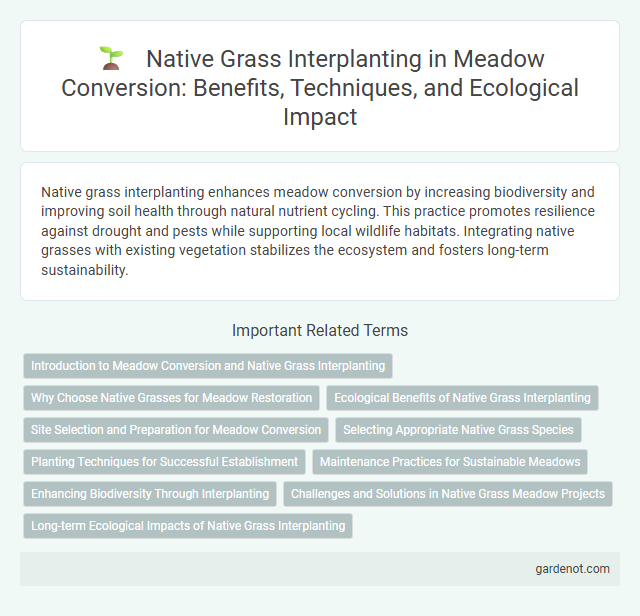Native grass interplanting enhances meadow conversion by increasing biodiversity and improving soil health through natural nutrient cycling. This practice promotes resilience against drought and pests while supporting local wildlife habitats. Integrating native grasses with existing vegetation stabilizes the ecosystem and fosters long-term sustainability.
Introduction to Meadow Conversion and Native Grass Interplanting
Meadow conversion enhances biodiversity by replacing lawns with native grass species that support local ecosystems and pollinators. Native grass interplanting involves integrating diverse indigenous grasses into existing turf to improve soil health, water retention, and habitat quality. This method promotes sustainability by reducing maintenance needs and fostering resilient, self-sustaining plant communities.
Why Choose Native Grasses for Meadow Restoration
Native grasses play a crucial role in meadow restoration by enhancing biodiversity and improving soil health through deep root systems that prevent erosion. Their adaptability to local climate conditions reduces the need for irrigation and chemical inputs, promoting sustainable ecosystem balance. Incorporating native grasses in meadow conversion supports habitat creation for pollinators and wildlife, fostering long-term ecological resilience.
Ecological Benefits of Native Grass Interplanting
Native grass interplanting in meadow conversion significantly enhances biodiversity by providing diverse habitats for pollinators, birds, and soil microorganisms. It improves soil health through deep root systems that increase organic matter and nutrient cycling, reducing erosion and promoting water retention. This practice supports ecosystem resilience by fostering balanced plant communities that adapt better to environmental stress and climate variability.
Site Selection and Preparation for Meadow Conversion
Effective site selection for meadow conversion emphasizes well-drained soils with full to partial sunlight, which support native grass interplanting and promote biodiversity. Preparation involves minimal soil disturbance to preserve the existing seed bank and soil structure, enhancing native grass establishment and ecological resilience. Removing invasive species and amending soil pH based on soil tests can optimize conditions for native grass growth and meadow sustainability.
Selecting Appropriate Native Grass Species
Selecting appropriate native grass species for meadow conversion involves evaluating regional climate, soil type, and existing biodiversity to ensure successful establishment and ecological balance. Species such as little bluestem (Schizachyrium scoparium), switchgrass (Panicum virgatum), and Indian grass (Sorghastrum nutans) are highly recommended for their adaptability and habitat benefits. Incorporating a diverse mix of native grasses enhances soil health, supports local wildlife, and increases resilience against invasive species.
Planting Techniques for Successful Establishment
Native grass interplanting in meadow conversion requires precise seed selection and site preparation to ensure successful establishment. Techniques such as drilling or broadcasting seeds, combined with light soil scarification, improve seed-to-soil contact and enhance germination rates. Timing the planting to coincide with optimal soil moisture and temperature conditions maximizes native grass growth and resilience.
Maintenance Practices for Sustainable Meadows
Native grass interplanting enhances biodiversity and soil structure in meadow conversion by promoting deep root systems that improve water retention. Regular mowing at optimal heights prevents invasive species without disrupting native grass development, supporting sustainable growth cycles. Incorporating seasonal monitoring ensures adaptive maintenance practices that align with local climate and ecosystem dynamics.
Enhancing Biodiversity Through Interplanting
Native grass interplanting significantly enhances biodiversity by creating a mosaic of habitats that support diverse wildlife species, including pollinators and ground-nesting birds. This method increases plant diversity and structural complexity, promoting soil health and resilience against pests and diseases. Incorporating a variety of native grasses during meadow conversion fosters ecological balance and strengthens ecosystem services.
Challenges and Solutions in Native Grass Meadow Projects
Native grass interplanting in meadow conversion faces challenges like competition from invasive species, soil nutrient variability, and inconsistent seed germination rates. Implementing adaptive management practices such as soil amendment, targeted weed control, and selective seeding techniques enhances establishment success. Utilizing site-specific native grass species matched to local soil and climate conditions significantly improves meadow resilience and biodiversity outcomes.
Long-term Ecological Impacts of Native Grass Interplanting
Native grass interplanting in meadow conversion enhances biodiversity by creating diverse habitats that support pollinators and soil microorganisms, leading to increased ecosystem resilience. Over time, root systems of native grasses improve soil structure and nutrient cycling, reducing erosion and promoting carbon sequestration. These long-term ecological impacts contribute significantly to sustainable land management and ecosystem stability.
Native grass interplanting, Infographic

 gardenot.com
gardenot.com